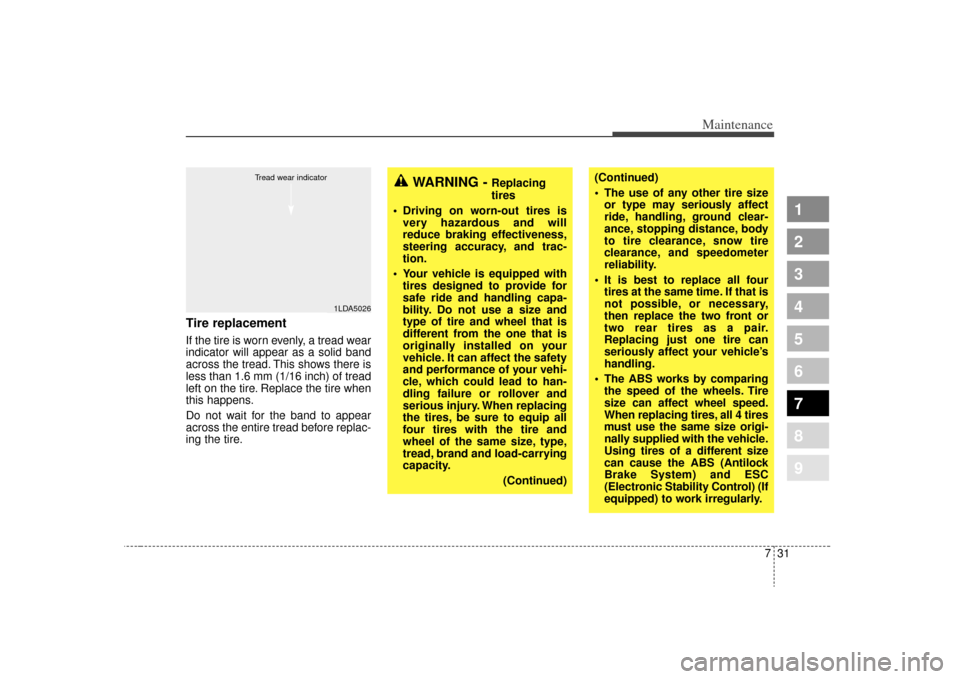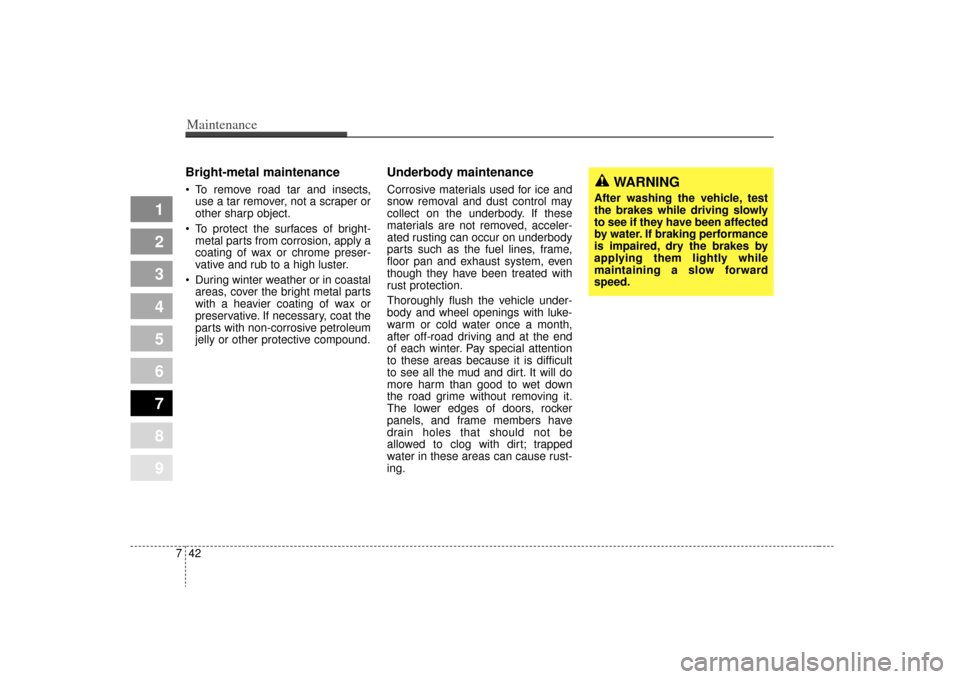2009 KIA Sephia brake
[x] Cancel search: brakePage 257 of 291

719
Maintenance
1
2
3
4
5
6
7
8
9
3. Confirm that the fluid level is in“HOT” range on the level gauge. If
the fluid level is lower, add the
specified fluid from the fill hole. If
the fluid level is higher, drain the
fluid from the drain hole.
4. If the fluid level is checked in cold condition (fluid temperature 20~
30 °C (68~86 °F) add the fluid to
“COLD (C)” line and then recheck
the fluid level according to the
above step 2.
✽ ✽NOTICE“COLD (C)” scale is for reference
only and should NOT be used to
determine transaxle fluid level.✽ ✽NOTICENew automatic transaxle fluid
should be red. The red dye is added
so the assembly plant can identify it
as automatic transaxle fluid and dis-
tinguish it from engine oil or
antifreeze. The red dye, which is not
an indicator of fluid quality, is not
permanent. As the vehicle is driven,
the automatic transaxle fluid will
begin to look darker. The color may
eventually appear light brown.
Therefore, have an Authorized Kia
dealer change the automatic
transaxle fluid according to the
Scheduled Maintenance at the
beginning of this section.Changing the automatic
transaxle fluidHave automatic transaxle fluid
changed by an authorized Kia dealer
according to the Maintenance
Schedule at the beginning of this
section.
CAUTION
Low fluid level causes
transaxle slippage. Overfillingcan cause foaming, loss of fluidand transaxle malfunction.
The use of a non-specified fluid could result in transaxle mal-function and failure.
WARNING
- Parking brake
To avoid sudden movement of
the vehicle, apply parking brake
and depress the brake pedal
before moving the shift lever.
OHD076045N
WARNING
- Transaxle
fluid
The transaxle fluid level should
be checked when the engine is at
normal operating temperature.
This means that the engine, radi-
ator, radiator hose and exhaust
system etc., are very hot.
Exercise great care not to burn
yourself during this procedure.
Page 268 of 291

Maintenance30
7
1
2
3
4
5
6
7
8
9
If you overfill the tire, release air by
pushing on the metal stem in the cen-
ter of the tire valve. Recheck the tire
pressure with the tire gage. Be sure
to put the valve caps back on the
valve stems. They help prevent leaks
by keeping out dirt and moisture.Tire rotation To equalize tread wear, it is recom-
mended that the tires be rotated
every 12,000 km (7,500 miles) or
sooner if irregular wear develops.
During rotation, check the tires for
correct balance.
When rotating tires, check for uneven
wear and damage. Abnormal wear is
usually caused by incorrect tire pres-
sure, improper wheel alignment, out-
of-balance wheels, severe braking or
severe cornering. Look for bumps or
bulges in the tread or side of tire.
Replace the tire if you find either of
these conditions. Replace the tire if
fabric or cord is visible. After rotation,
be sure to bring the front and rear tire
pressures to specification and check
lug nut tightness.
Refer to Section 8, Specifications.
Disc brake pads should be inspected
for wear whenever tires are rotated.Rotate radial tires that have an
asymmetric tread pattern only
from front to rear and not from
right to left.
CBGQ0707CBGQ0707A
Do not include compact spare tire in rotation.
Directional tires (if equipped)
WARNING
Do not use the temporary spare tire for tire rotation.
Do not mix bias ply and radial ply tires under any circum-
stances. This may cause
unusual handling characteris-
tics that could result in death,
severe injury, or property
damage.
Page 269 of 291

731
Maintenance
1
2
3
4
5
6
7
8
9
Tire replacementIf the tire is worn evenly, a tread wear
indicator will appear as a solid band
across the tread. This shows there is
less than 1.6 mm (1/16 inch) of tread
left on the tire. Replace the tire when
this happens.
Do not wait for the band to appear
across the entire tread before replac-
ing the tire.
1LDA5026
Tread wear indicator
WARNING -
Replacing
tires
Driving on worn-out tires is very hazardous and will
reduce braking effectiveness,
steering accuracy, and trac-
tion.
Your vehicle is equipped with tires designed to provide for
safe ride and handling capa-
bility. Do not use a size and
type of tire and wheel that is
different from the one that is
originally installed on your
vehicle. It can affect the safety
and performance of your vehi-
cle, which could lead to han-
dling failure or rollover and
serious injury. When replacing
the tires, be sure to equip all
four tires with the tire and
wheel of the same size, type,
tread, brand and load-carrying
capacity.
(Continued)
(Continued)
The use of any other tire sizeor type may seriously affect
ride, handling, ground clear-
ance, stopping distance, body
to tire clearance, snow tire
clearance, and speedometer
reliability.
It is best to replace all four tires at the same time. If that is
not possible, or necessary,
then replace the two front or
two rear tires as a pair.
Replacing just one tire can
seriously affect your vehicle’s
handling.
The ABS works by comparing the speed of the wheels. Tire
size can affect wheel speed.
When replacing tires, all 4 tires
must use the same size origi-
nally supplied with the vehicle.
Using tires of a different size
can cause the ABS (Antilock
Brake System) and ESC
(Electronic Stability Control) (If
equipped) to work irregularly.
Page 280 of 291

Maintenance42
7
1
2
3
4
5
6
7
8
9
Bright-metal maintenance To remove road tar and insects,
use a tar remover, not a scraper or
other sharp object.
To protect the surfaces of bright- metal parts from corrosion, apply a
coating of wax or chrome preser-
vative and rub to a high luster.
During winter weather or in coastal areas, cover the bright metal parts
with a heavier coating of wax or
preservative. If necessary, coat the
parts with non-corrosive petroleum
jelly or other protective compound.
Underbody maintenanceCorrosive materials used for ice and
snow removal and dust control may
collect on the underbody. If these
materials are not removed, acceler-
ated rusting can occur on underbody
parts such as the fuel lines, frame,
floor pan and exhaust system, even
though they have been treated with
rust protection.
Thoroughly flush the vehicle under-
body and wheel openings with luke-
warm or cold water once a month,
after off-road driving and at the end
of each winter. Pay special attention
to these areas because it is difficult
to see all the mud and dirt. It will do
more harm than good to wet down
the road grime without removing it.
The lower edges of doors, rocker
panels, and frame members have
drain holes that should not be
allowed to clog with dirt; trapped
water in these areas can cause rust-
ing.
WARNING
After washing the vehicle, test
the brakes while driving slowly
to see if they have been affected
by water. If braking performance
is impaired, dry the brakes by
applying them lightly while
maintaining a slow forward
speed.
Page 286 of 291

Specifications48
1
2
3
4
5
6
7
8
9
RECOMMENDED LUBRICANTS AND CAPACITIES To help achieve proper engine and powertrain performance and durability, use only lubricants of the proper quality.
The correct lubricants also help promote engine efficiency that results in improved fuel economy.These lubricants and fluids are recommended for use in your vehicle.*1Refer to the recommended SAE viscosity numbers on the next page.
*2Engine oils labeled Energy Conserving Oil are now available. Along with other additional benefits, they contribute to fuel economy by reducing the amount of fuel nec-
essary to overcome engine friction. Often, these improvements are difficult to measure in everyday driving, but in a year’s time, they can offer significant cost and
energy savings.Lubricant Volume Classification
Engine oil
*1 *2
4.0 l (4.23 US qt.)
(drain and refill)
Manual transaxle fluid 2.0 l (2.11 US qt.)
Automatic transaxle fluid 6.6 l (6.97 US qt.) DIAMOND ATF SP-III
Power steering fluid 0.8 l (0.85 US qt.)
Coolant 6.6 l (6.97 US qt.)
Brake/Clutch fluid 0.7~0.8
l
(0.7~0.8 US qt.)
Fuel 53 l (14 US gal.) -
API Service SL or SM,
ILSAC GF-3 or above
API Service GL-4 (SAE 75W-85, fill for-life)
PSF-III
FMVSS116 DOT-3 or DOT-4
MIXTURE, Antifreeze with water
(Ethylene glycol base coolant for aluminum radiator)
Page 289 of 291

Index29
1
2
3
4
5
6
7
8
9
Air bag - supplemental restraint system....................3-50
Air cleaner....................................................................7-21\
Antenna ........................................................................\
3-91
Audio system ................................................................3-92
Automatic transaxle.............................................4-6, 7-18
Battery ........................................................................\
..7-25
Before driving ................................................................5-5
Brake system ................................................................4-11
Brakes and clutch ........................................................7-15
Climate control air filter.............................................7-22
Cruise control ..............................................................4-21
Defroster .......................................................................4\
-45
Door locks ......................................................................3-\
8
Electrical circuit protection........................................6-12
Emergency starting .......................................................6-9
Emission control system ...............................................5-3
Engine compartment ...........................................2-4, 7-10 Engine cooling system .................................................7-12
Engine oil and oil filter ...............................................7-11
Exterior care ................................................................7-40
Fuel filler lid ................................................................3-73
Fuel requirements .........................................................5-2
Gauges ........................................................................\
..4-29
Hazard warning flasher ..............................................4-46
Hood....................................................................\
..........3-71
How to use this manual ................................................1-2
If you have a flat tire...................................................6-24
Ignition switch ...............................................................4-2
Immobilizer system .......................................................3-6
In case of an emergency while driving ........................6-2
Instrument cluster .......................................................4-28
Instrument panel overview...........................................2-3
Interior care .................................................................7-44
Interior features...........................................................3-83
Interior lights ...............................................................3-80
Interior overview ...........................................................2-2ABCDE
GFHI
Page 290 of 291

93
1
2
3
4
5
6
7
8
9
Index
Keys ........................................................................\
........3-2
Label information........................................................5-25
Lighting ........................................................................\
4-38
Lubricants and fluids ..................................................7-20
Luggage net ..................................................................3-90
Maintenance schedule ...................................................7-3
Maintenance services ....................................................7-2
Manual climate control system ..................................4-47
Manual transaxle .................................................4-5, 7-18
Mirrors ........................................................................\
.3-76
Overheating.............................................................\
.......6-8
Owner maintenance ......................................................7-7
Parking brake ..............................................................7-16
Power steering .............................................................7-17Remote keyless entry ....................................................3-3
Road warning ................................................................6-2
Safety belts ...................................................................3-27
Seat....................................................................\
............3-16
Special driving conditions ............................................5-7
Specifications .................................................................8-2
Starting the engine ........................................................4-4
Steering wheel ..............................................................4-18
Storage compartment ..................................................3-81
Suggestions for economical operation .........................5-6
Sunroof ........................................................................\
.3-87
Tires and wheels ..........................................................7-28
Tires pressure monitoring system (TPMS) .................6-3
Towing ........................................................................\
..6-19
Traction control system ..............................................4-25
Trailer towing ..............................................................5-17
Trunk ........................................................................\
....3-69
Vehicle break-in process ...............................................1-3
Vehicle load limit .........................................................5-11KLMOP
RSTV